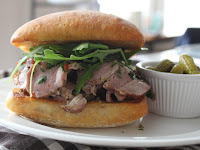
Tiramisu – It Will Pick You Up and Not Let You Down
pada 22.07.00
In addition to being an incredible tasting dessert, Tiramisu also offers the perfect segue when you’re trying to steer the Valentine’s dinner conversation towards spicier subjects. Please feel free to embellish the following history to further enhance the version your sweetheart hears.
Tiramisu was invented in an Italian brothel, where it was a popular snack with customers looking for a little restorative treat after certain strenuous activities. Tiramisu actually means “pick-me-up,” which of course makes it the best culinary double entendre in history.
Besides the great story, it really is the perfect romantic occasion dessert. This heady, mood-elevating concoction is a rich and deeply satisfying, yet remarkably light in texture. I know someone will ask, so yes you can use regular cream cheese, but mascarpone is far superior, and it is Valentine’s Day after all.
As far as the booze goes, I used Marsala, but it also works beautifully with amoretti, rum, brandy, or even Bailey’s. The other key liquid in this is the espresso, and I highly recommend that’s what you use. Regular coffee doesn’t have the same punch. You can use instant, but the last time I checked there was literally a café on every corner of every city.
I did these as two, rather large individual portions, but this could be easily stretched into four cups, or layered in a square baking dish, as is more traditional. Don’t over-think it; no matter what you use, it’s basically three layers of mascarpone mixture around two layers of coffee-dipped ladyfingers.
They say you can tell how good your Valentine's dessert was, by whether or not you end up also having to cook breakfast. Which reminds me, if you make this, be sure to not use up the last of the eggs. I really hope you give this tiramisu a try soon. Enjoy!
They say you can tell how good your Valentine's dessert was, by whether or not you end up also having to cook breakfast. Which reminds me, if you make this, be sure to not use up the last of the eggs. I really hope you give this tiramisu a try soon. Enjoy!
Ingredients for 2 large or 4 small portions:
1/2 cup espresso with 2 tbsp Marsala wine for dipping cookies
10 or 12 ladyfinger cookies, broken in half if making cups
2 large egg yolks
2 tablespoons plus one teaspoon white sugar
1/2 tsp vanilla
pinch of salt
3/4 cup mascarpone cheese (6 oz)
2 large egg whites
cocoa for dusting
dark chocolate for shaving



























